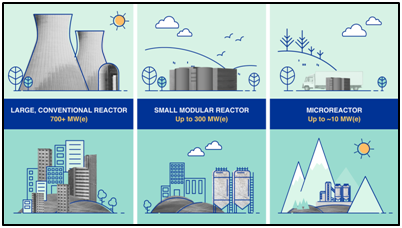Context:
Recently, Google announced the “first corporate agreement” to buy nuclear energy from multiple small modular reactors (SMR). These SMRs will be developed by Kairos Power. The initial phase of work will bring up the first SMR by 2030, and subsequent deployments will continue through 2035. Per Google, this deal will provide 500 MW of carbon-free power to U.S. electricity grid. The search giant said this agreement will help in the development of AI technologies to power major scientific advances.
Relevance:
GS III: Nuclear Technology
Dimensions of the Article:
- Google Interest in Nuclear Energy
- Broader Tech Industry Engagement
- Some Controversy and Challenges with Nuclear Energy
- Nuclear Energy Today with the U.S. Government
Google Interest in Nuclear Energy
- Energy requirements of AI: All the AI-related technologies and data centers consume a lot of energy. And with its increasing applications, similarly the power needs will grow to power the system continuously.
- Sustainability Goals: Google would also like to decrease its greenhouse gas emissions even though the company is growing from its operations. Assuming that nuclear energy was a non-carbon option without a variability problem, this seems to fit with its clean energy plan.
- Next Generation Nuclear Technologies: Next-generation nuclear reactors are of special interest to Google because of their smaller footprint and quicker deployment capabilities due to its more modular design.
Broader Tech Industry Engagement
- Microsoft: In collaboration with Constellation, will tap nuclear power from the Crane Clean Energy Center as part of its aim to decarbonize the grid.
- Amazon: Entered multiple deals to further nuclear energy projects, including investment in SMRs (Small Modular Reactors) and partnerships that will directly power its data centers by nuclear energy.
- OpenAI and Sam Altman: This investment in oklo and Helion nuclear startups suggests the direction for technological leaders who believe that nuclear energy is a future- viable option for further technological developments.
Some Controversy and Challenges with Nuclear Energy
- Safety Concerns: Despite many countries considering nuclear energy to be an ideal solution, the background of nuclear energy has always been controversial with most severe accidents being associated with Chernobyl and Fukushima disasters leaving permanent environmental impacts and public fears.
- Environmental Opposition: Groups, like Friends of the Earth, oppose nuclear power because of its perceived hazards, particularly in earthquake-prone areas, and past challenges with both waste and accidents.
- Small Modular Reactors (SMRs): One of the new bright promises for nuclear futures is that SMRs potentially offer reduced cost, greater safety designs, and a higher probability of deployment in different sites because they are much smaller in size.
Nuclear Energy Today with the U.S. Government
- Strategic Energy Planning: The U.S. Department of Energy views nuclear power as a core component of the national clean energy strategy, reducing carbon emissions and maintaining energy independence.
- Global Leadership: There is strategic focus on regaining U.S. leadership in nuclear technology primarily because more and more nations worldwide are entering nuclear energy, and America cannot afford to play a losing game with countries like Russia and China.
Small Modular Reactors

Small Modular Reactors (SMRs) are advanced nuclear reactors designed to have a smaller power capacity compared to traditional nuclear power reactors. Here are the key characteristics, advantages, safety features, and disadvantages of SMRs:
Characteristics:
- Small: SMRs have a power capacity of up to 300 MW per unit, which is about one-third of the generating capacity of conventional nuclear reactors.
- Modular: SMRs are designed to be modular and portable. Components can be factory-assembled and transported as units to installation sites.
- Reactors: SMRs use nuclear fission to generate heat for electricity production.
Advantages:
- Efficiency: SMRs are designed for high capacity factors (exceeding 90%) and can produce a significant amount of low-carbon electricity.
- Hybrid Energy Systems: SMRs can complement renewable energy sources by providing consistent power, enhancing overall system efficiency.
- Off-Site Manufacturing: Factory assembly of components saves construction time and reduces costs.
- Lower Costs: SMRs are designed for cost-effectiveness, requiring less fuel and fewer staff for assembly, maintenance, and operation.
- Flexibility: SMRs can adjust electricity generation based on demand, making them suitable for remote locations.
- Site Repurposing: SMRs can be installed in existing thermal power plant sites by repurposing infrastructure.
Safety Features:
- Reduced Risk: SMRs are designed with lower core damage frequency and radioactive contamination compared to conventional nuclear power plants (NPPs).
- Enhanced Seismic Isolation: SMRs incorporate advanced seismic isolation techniques for improved safety during earthquakes.
- Passive Safety: SMRs feature passive safety systems, minimizing the potential release of radioactive materials.
-Source: The Hindu



